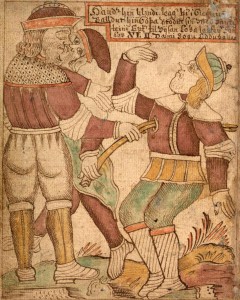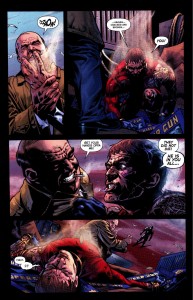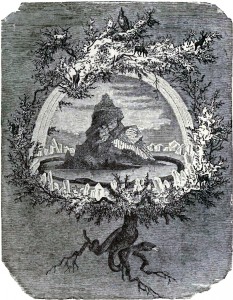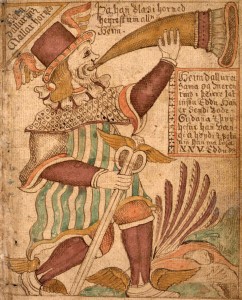Death as a Beginning.
Both Ragnarök and Final Crisis begin with the unthinkable: the death of a god. For Ragnarök, it is the death of Baldr that signifies that something is very wrong in the world and that a great change is about to take place, as LoCicero says, “[t]he tragic death of Baldr was the single event that set the wheels of the Norse Apocalypse into motion” (LoCicero 142). O’Donoghue agrees, taking not also of the narrative shift that occurs in the story:[t]he death of Baldr is recounted just as the volva moves from recollection to prophetic vision, and his killing is presented as a decisive event in the inexorable progress to Ragnarök (O’Donoghue “What“ 87). For Final Crisis it is the death of Orion in the first chapter that portends the great disasters about to happen.
The deaths of both Baldr and Orion take place at the hands of family. Baldr was killed unwittingly by his blind brother Hod. For some time, Baldr had been having dreams about his impending death. Baldr’s mother Frigg petitions all things on earth to keep Baldr from harm, all things that is save for mistletoe, which she did not see as a threat. To celebrate his invulnerability, all of the Gods attempt to hurt Baldr with anything they can find. Hod, Baldr’s brother does not take part in the festivities because he is blind. Loki, the Norse trickster god and agent of chaos chides Hod for not participating and then gives him a spear of mistletoe and guides his aim. Baldr is struck by the mistletoe and immediately falls dead. The gods then go to Hel, the goddess of the underworld and the dead and ask her to return Baldr to life. Hel says that she will do so only if everyone on earth sheds tears for Baldr. The gods send messengers all over the world and ask everyone to weep for Baldr and all do except for Loki in the guise of a giantess and so Baldr must remain dead. Ultimately, Baldr is reborn after the events of Ragnarök and he reconciles with his brother Hod and they become gods of the new world (Sturluson 65-68, 77).
Because one of the main points of Final Crisis is that time and space have become distorted and are gradually breaking apart, the death of Orion is fragmented. Orion is shown dying in chapter one, where he warns detective Turpin that Darkseid and the other evil New Gods are hiding on earth. The moment when the bullet strikes Orion is shown in chapter three and Darkseid is seen firing the bullet in chapter ten. Incidentally, because of the time distortions, when Darkseid fires the bullet he is on the verge of death from being shot earlier by Batman in chapter nine with the very same bullet. Like Baldr, Orion dies at the hand of family, in this case, his father the tyrant god Darkseid. But unlike Baldr whose brother Hod unwittingly kills him, Orion’s murder is deliberate. Orion is killed by his father, presumably because Darkseid saw his son as being the only one who could stop him. After all, when addressing the other members of the Justice League in chapter one, Superman speaks of the power wielded by the New Gods with a kind of awe, saying that they are “capable of cracking the planet in half” (Morrison Chapter 1).
Each death in its own way contributes to the destruction that follows. Although Baldr is killed by his brother, the murder is engineered by Loki, the Norse trickster god. For the sole purpose it seems, of bringing chaos and disorder to the world of the gods. In a pantheon of warrior-gods, Baldr stands very much apart from the rest due to his beauty and gentle nature: “the best of all gods: the most beautiful (so radiant he glows) and the wisest. He is also the most merciful” (O’Donoghue Norse 74). Baldr’s death takes the other gods completely by surprise, not only because they believed him to be immortal but because he was so gentle and radiant. “Baldr’s death left the gods speechless and so weak that they were unable to muster the strength to lift him in their arms” (Sturluson 66). In the context of the story, his death seems almost absurd, which is precisely Loki’s goal. This introduction of randomness or chaos into the lives of the gods is the moment that their world begins to fall apart. It is possible that ancient people from whom the myth of Ragnarök originally came placed a high value on the notion of order and (as much as was possible) predictability and stability. So the death of a god, particularly one as beloved as Baldr would seem like “the beginning of the end.”
In Volume three of Jack Kirby’s Fourth World Omnibus, in a story titled “The Pact,” which was originally published as The New Gods #7 in 1972, Orion’s adopted father Highfather, the leader of the Gods of New Genesis, refers to Orion having a “great destiny” (Kirby 88). In the Fourth World Omnibus volume 4, Orion speaks of a prophecy, saying that” “it is written that the father of Apokalipse shall meet his banished sons in the red light of the fire pits—and there they shall decide this war…I am Darkseid’s son! When I clash with Darkseid the war will end! (Kirby 77). Orion is fierce, a god of war. Although he was raised on New Genesis, he has never been able to quell his ferocity or his fiery temper. Instead, Orion has devoted his life to channeling his aggression toward defeating the forces of Darkseid. Before the prophecy can be fulfilled however, Darkseid murders his son with a bullet that is fired backwards through time, “[f]rom here where he no longer exists, Orion cannot see me. As all times become one time, the time has come to strike” (Morrison, chapter 10). In so doing, Darkseid thwarts prophecy, usurping it with his own vision of order. This usurpation of the future and brute imposition of will is what sets in motion the events of Final Crisis. If Loki, as a chaotic trickster god, is seen is the great villain of Ragnarök, or at least the one who puts in into motion, then it reflects in some way the perception of randomness or chaos in the ancient world. Darkseid is a tyrant and as such his nature is the exact opposite of Loki’s. Darkseid exists to impose his strict order upon every living being in the universe through the spread of the “Anti-Life Equation”–mathematical proof that free will is an illusion. At the end of chapter three, Darkseid’s agents unleash the Anti-Life Equation through every electronic system on earth, anyone who hears it becomes an extension of Darkseid, and thus his absolute rule is established on earth. If ancient people feared chaos, then it seems people of the 21st century fear tyranny and the loss of free will.
Ultimately, for both Baldr and Orion, their futures do not end with their murders. Baldr is reborn at the end of Ragnarök as is his brother Hod to become gods of the new world. As for Orion, When Darkseid is finally destroyed through the combined efforts of Batman and DC’s speedster hero The Flash his body becomes a singularity, “a black hole at the base of creation” (Morrison, chapter 10), and from this singularity Apokalipse is reborn as New Genesis. While the New Gods, most of whom had died before the events of Final Crisis (or “off panel” as they say in comics) are also reborn, “returned to guide the destiny of a new world” (Morrison chapter 10). Carl Jung speaks of this idea of death and resurrection of gods as a reflection of humanity’s desire to evolve and change, saying: “the connection between the suprapersonal or collective unconscious means an extension of man beyond himself; it means death for his personal being and a rebirth in a new dimension, as was literally enacted in certain of the ancient mysteries. It is certainly true that without the sacrifice of man as he is, man as he was—and always will be—cannot be attained” (Segal 103). The need to grow, to learn, to evolve has been a part of humanity’s DNA from the very beginning and this is reflected in myths both ancient and (post) modern.
The Ash and the Orrery.
Norse mythology holds that the known universe is divided roughly into nine worlds, all of which are connected through the great ash tree Yggdrasil:
Nine worlds I knew, the nine in the tree
With mighty roots beneath the mold. (Bellows 3 Stanza 2)
The nine worlds are: Asgard, Midgard, Niflheim, Alfheim, Vanaheim, Muspellheim, Svartalfaheim, Jotunheim, and Hel. In Norse mythology, these worlds are defined based on their inhabitants or their properties: gods:Asgard, Vanaheim, humans: Midgard, giants: Jotunheim, Elves: Alfheim, Svartalfaheim, the dead: Hel, ice: Niflheim and fire: Muspellheim (Lindow). These worlds are all connected to the great Ash tree, Yggdrasil, “located in the center of the universe, uniting it” (Lindow 319). Davidson describes Yggdrasil as “the fixed center of this series of worlds which were believed to have had a definite beginning and to be destined to eventual destruction” (190). Lindow also says that. “[t]he tree functions on both the vertical axis (trunk) and the horizontal axis (roots) and structural readings of mythology, such as those of Eleazar Meletinskij, have suggested that these have varying functions: wisdom on the vertical axis and history on the horizontal axis…the tree brings not just spatial unity to the mythology…it also brought chronological unity” (Lindow 321,322). Norse mythology therefore depicts the universe as a group of worlds connected through living matter, the tree and all of time and space exist within it.
The DC Universe exists as a multiverse that consists of fifty-two parallel earths, and thus fifty-two parallel realities. In Final Crisis, we see a great machine called the “Multiversal Orrery,” within which resides the fifty-two earths of the multiverse. The Orrery is watched-over by a group of celestial beings known as “The Monitors.” According to Morrison, the Monitors are “named after writer-gods from different cultures. So Uotan is named after Odin or Wotan from the Norse/Germanic tradition. Ogama is Ogma from the Celtic gods. Hermuz is after Hermes, the Greek god. Tahoteh is after Thoth, the Egyptian god” (Morrison IGN 2). It is fitting that this fictional universe is constantly being observed by gods of writing.
The common theme between the two depictions of the universe is the idea that there is more than one world, that indeed there are numerous other worlds and that they are all connected. Physicist Michio Kaku, in his book Parallel Worlds writes about the idea of multiple universes saying, we may live in a sea of such universes, like a bubble floating in an ocean of other bubbles. In fact, a better word than ‘universe’ would be ‘multiverse’ or ‘megaverse’”(14). Of course, the idea of multiple universes has been a part of comic books, almost since they were invented. Morrison himself has used it as a plot device in many of his stories like The Invisibles, Animal Man, and even his earliest work, Zenith. But what about the ancient cultures from which the story of Ragnarök first arose? Consider the depiction of the universe: multiple worlds connected by a great ash tree–universes connected by a living organism. Perhaps these people knew intuitively what physicists today are just now beginning to consider. Take for example Kaku’s illustration of inflation:
According to this theory[inflation], a tiny patch of a universe may suddenly inflate and “bud,” sprouting “daughter” universe or “baby” universe, which may in turn bud another baby universe, with this budding process continuing forever. Imagine blowing soap bubbles into the air. If we blow hard enough, we see that some of the soap bubbles split in half and generate new soap bubbles. In the same way, universes may be continually giving birth to new universes. (Kaku 14)
The terms he uses, like “bud” and “sprouting” evoke plant imagery. Morrison’s depiction of the Multiversal Orrery is entirely mechanical save for the fifty-two earths all interconnected, yet the image recalls the Sephirot, the Qabalistic “Tree of Life.”
The theory of parallel universes is also based on the idea known as “string theory:” [y]ou can think of it [matter] as a violin string or a guitar string. If you pluck it a certain way you get a certain frequency. But if you pluck it a different way you can get more frequencies on this string and in fact you have different notes. Nature is made up of the notes, all of these musical notes that are played on these superstrings (Ovrut Horizon). Kaku goes on to say that “ [t]he universe is a symphony and the laws of physics are harmonies of a superstring” (Kaku Horizon). This connection of vibration and sound and music with the mechanics of the universe appears in both Ragnarök and Final Crisis. Consider this scene from Ragnarök:
…and fate
is heard in the note of the Gjallarhorn;
Loud blows Heimdall the horn is aloft,
In fear quake all who on Hel-roads are. (Bellows 20 Stanza 46)
Sturluson, in his version, adds a crucial element by mentioning Yggdrasil, thus showing that the sound of the Gjallarhorn resonates throughout the entire universe: “Heimdall stands up and blows the Gjallarhorn with all his strength. He awakens all the gods…the ash Yggdrasil shakes, and nothing, whether in heaven or earth is without fear” (72). The last chapter of Final Crisis, chapter ten, opens on an alternate earth where Nubia, a Wonder Woman analogue uses a gigantic machine called “the Wonder Horn,” which, as she says is “a gift from the Universals in mythic time before time…”to be used only once, when all else has failed.” With it, she summons not only the heroes of her earth, but the heroes from other universes as well (although it is never said, it is almost certain that Morrison had the Gjallarhorn in mind when he wrote this sequence). The Superman of this alternate world describes the music of the Wonder Horn as “universe shaking.”Chapters four and five of Final Crisis focus on Superman as he attempts to save the life of his wife, Lois Lane. Superman is told by one of the Monitors that the only way to save Lois’s life is with a substance known as “The Bleed.” The Bleed exists between the various universes and it binds them together. Superman then goes on a journey with other Supermen from the multiverse to fight the ultimate evil, Mandrakk—a twisted, vampiric Monitor who exists to devour stories and who seeks to wipe out all of existence. The ship that the Supermen use to travel throughout the multiverse, the Ultima Thule (which, incidentally bares a strong resemblance to the Beatles’ Yellow Submarine), is powered by universal vibrations. Just before it crashes, Captain Marvel says “the ship’s completely out of tune! Either that or the whole universe is out of tune!” (chapter 4). Later, at the climax of the story, Superman—the Superman from the DC universe proper—confronts the disembodied spirit of Darkseid, armed with the knowledge he gained during his journey through the multiverse, and says “the worlds of the multiverse vibrate together Darkseid, and make this…sound like an orchestra. Everything’s just vibrations, really. And counter-vibrations that cancel them out.” Superman then sings the sound of the Wonder Horn—the sound identified earlier as the “music of the spheres, the sound of the tides of the infinite,” and Darkseid is destroyed, or rather converted into a black hole existing “at the base of creation”
The great ash Yggdrasil, with its branches and roots joining together various worlds, and the Multiversal Orrery with each of the fifty-two worlds of the DC universe all united within a great machine seem to be related to the idea of matter being made up of “strings” that connect not just the worlds, but everything within them. Morrison, in an interview with, echoes this idea:
There’s one organism that lives in the planet earth, one living thing, and it’s three billion years old, And we’re all connected through time to the first mitochondrial DNA cell that appeared in the ocean three and a half billion years ago; that cell has divided through time, and that cell is in every one of your cells still dividing. So we call contain part of this primordial cell (Morrison Publishers Weekly).
Physicist and philosopher David Bohm, whose books have been an influence on Morrison’s stories over the years (in an issue of Animal Man, Bohm’s book Unfolding Meaning can be clearly seen in one panel), speaks of a theory of “Implicate Order” where all matter in the universe is connected. Additionally, Bohm states that, “The mental and the material are two sides to one reality” (20). In explaining this bold assertion, Bohm says:
The implicate order suggests a possible solution to the Cartesian duality which has pervaded much of human thinking over the ages. Instead of saying that there are two orders—the explicate order of extended structure and something like an implicate order of thinking—we are proposing, to a large extent, on the basis of recent development in physics, that matter is also that way. And if we extend it to say that brain matter and nerve matter are that way, then in some way perhaps, mind and matter interweave. (20)
Morrison seems to be explicitly addressing this point in chapter five of Final Crisis with the character Captain Atom, the “Quantum Superman of Earth 4” who, upon seeing a glimpse of the mechanics of the universe says “there are no dualities. Only symmetries.” Both Morrison and Bohm seem to be echoing sentiments expressed by Joseph Campbell who says, “the universal doctrine teaches that all the visible structures in the world—all things and beings—are the effects of a ubiquitous power out of which they rise, which supports and fills them during the period of their manifestation and back into which they must dissolve” (221).
Time and Rebirth.
Ragnarök is a story that seems to exist out of time. It is told as a kind of prophecy, but a prophecy for an ancient time, a time before the Christian god came to prominence among the people of Northern Europe, as Lindow notes: “[a]ccording to the Hauksbok redaction of the poem, ‘the powerful one’ then comes, and this looks like a reference to the Christian deity”(257). Because it is neither wholly past or future, history or prophecy, The story of Ragnarök exists as a kind of fractured alternate reality where time is uncertain, which adds to the feeling of chaos and of living in a world where everything, even reality, is collapsing. Final Crisis, as noted earlier, is a story where time and space are gradually breaking breaking apart. Morrison says in an interview that Final Crisis is “all about endings and apocalypses. It shows the DCU degrading, drained of all meaning, drained even of stories and characters, reduced to nothing but darkness…. We even break down the conventional storytelling modes at the end until there’s nothing familiar left in an effort to convey what the end of a universe might feel like”(Morrison Newsarama).The early chapters are mostly laid out sequentially, giving the reader a sense of time passing and events progressing more or less logically. However, by the fourth chapter, the distortions of time and space brought on by Darkseid begin to manifest themselves metatextually in the panel layouts on the page as well as the shift in art (J.G. Jones, the artist on the first three issues fell behind and other artists, most notably Doug Mahnke, were brought in to complete the story). The story itself also jumps from scene to scene with little regard for continuity. All of this serves to create within the reader a sense of apocalyptic dread and also uncertainty. The uncertainty is a key point for Final Crisis. Anyone who reads mainstream comics, knows that by the end of the story the villain will be defeated and order will be restored, and of course, Final Crisis is no exception. By the end, evil has been vanquished and order is in the process of being restored. However, for Final Crisis the ending seems less important (largely because it is a foregone conclusion) than everything leading to it. Morrison says he was concerned with “unmaking the DC Universe to the point of destruction then showing how its own internal rules will work to homeostatically reset it, Superman always saves the day or he’s not Superman. It’s a self-perpetuating idea” (Morrison IGN 1). Morrison seems to approach the DC Universe as if it were a kind of sentient being, which is in keeping with his general ideas about the nature of the universe, fictional or otherwise.
The myth of Ragnarök and Final Crisis both end with new beginnings. Westley Bergen says that “if apocalyptic literature is written to groups in crisis, it must offer them something in response to that crisis” (Bergen 10). Indeed both stories offer the promise of a rebirth, that life will continue ”[t]he earth will shoot up from the sea, and it will be green and beautiful” (Sturluson 77). In the story of Ragnarök, the rebirth of the universe speaks to the idea of change and growth. The old Gods die and their sons take their place and in time these sons too will die and another God will replace them. For Final Crisis, Morrison chooses to show the destruction and rebirth of the DC Universe as a metatextual commentary on the circular nature of the universe and of stories. The remaining free humans and superheroes on earth put all of the stories of everything that has so far transpired into a rocket and fire the rocket out into the multiverse, reminiscent of Superman’s origins where his Kryptonian parents placed him in a rocket and sent him to Earth before his homeworld Krypton exploded. So the DC Universe “ends” in exactly the same way it began—in Action Comics #1 in 1937—with a rocket fired from a doomed planet. The rebirth of the DC multiverse occurs when Superman, using a device referred to alternately as a “God Weapon” and “The Miracle Machine” (chapter 9) wishes for a happy ending at the exact moment the multiverse collapses. Thus, the DC Universe is restored. But for how long?
Conclusion.
When people think of mythology, the images most often conjured in their minds belong to stories that are thousands of years old. Yet mythology has always been a part of our existence and we will continue to create new mythologies and revise old ones until we cease to exist. In the 21st century, we live in a world of instantaneous communication and access to knowledge, the possibility of parallel universes and alternate realities. Fire and stones have been replaced by electricity and silicon. Jung says that “[n]uclear Physics has begotten in the layman’s head an uncertainty of judgment that far exceeds that of physicists and makes things appear possible which but a short time ago would have been declared nonsensical” (Segal 71). Marshal McLuhan says “myth is the instant vision of a complex process that ordinarily extends over a long period. Myth is contraction or implosion of any process, and the instant speed of electricity confers the mythic dimension on ordinary and social action today. We live mythically but continue to think fragmentally and on single planes” (McLuhan, 25).We live God-like lives, yet we seldom acknowledge it. And because our experiences are so different from those of our ancestors, our mythologies are also different, at least with regard to how we present them. Don LoCicero, in his book Superheros and Gods says that:
modern representatives of the superhero genre are no less impressive than their predecessors in that illustrious fraternity. However, while in antiquity the orally transmitted epic poem was the medium in which tales of heroic exploits were circulated to a limited audience, today the superhero’s prowess is readily available worldwide by means of mass produced books, countless moving pictures and television productions and through internet search engines. (5)
To study mythology is to study humanity. In examining the cosmologies and apocalyptic myths of two cultures separated by a not only language and culture but also more than one thousand years of history, it is possible to see that ancient people intuitively grasped ideas that are only now being speculated upon and considered within the scientific community. It is also possible to see another truth, Character names change over time and the way stories are told change, but the stories themselves change very little. Worlds die and are reborn. Heroes rise up to face seemingly unstoppable evil. Gods and heroes alike may die, but they will live forever in stories and imagination.
.
Works Cited.
The Poetic Edda: The Mythological Poems. 1923. Trans. Henry Adams Bellows. New York: Dover, 2004.
Bergen, Westley J. “The New Apocalyptic: Modern American Apocalyptic Fiction and its Ancient and Modern Roots.” Journal of Religion and Popular Culture. Fall 2008 vol. 20 1-15.
Bohm, David. Unfolding Meaning: A Weekend of Dialogue. New York, Routledge, 1985.
Campbell, Joseph. The Hero with a Thousand Faces. 1949. Novato: New World, 2008.
Davis, H.R. Ellis. Gods and Myths of Northern Europe. New York: Penguin, 1965.
Evanier, Mark. Kirby: King of Comics. New York: Abrams, 2008.
Kaku, Michio. Parallel Worlds: A Journey Through Creation, Higher Dimensions, and the Future of the Cosmos. New York: Doubleday, 2005
Kirby, Jack. Mark Evanier, Grant Morrison, et al. Jack Kirby’s Fourth World Omnibus. 4 vols. New York: DC Comics, 2007, 2008.
Lindow, John. Norse Mythology: A Guide to the Gods, Heroes, Rituals, and Beliefs. Oxford: Oxford University Press, 2001.
LoCicero, Don. Superheroes and Gods: A Comparative Study from Babylonia to Batman. Jefferson: McFarland, 2008.
McLuhan, Marshall. Understanding Media: The Extensions of Man. 1964. Massachusetts: MIT Press, 1994.
Morrison, Grant J.G. Jones, et al. Final Crisis. 2008. New York, DC Comics 2009.
—. Interview with Dan Phillips. “Inside the Mind of Grant Morrison.” IGN.com. February 3, 2009: 1-6. http://comics.ign.com/articles/950/950703p1.html
—. Interview with David A. Lewis. “Grant Morrison Talks Comics, Magic, Life and Death.” Publishers Weekly. August 12, 2008. http://www.publishersweekly.com/article/CA6586371.html
—. Interview with Matt Brady. “Final Crisis Exit Interview, Part 1 ” Newsarama.com. 28 January, 2009: http://www.newsarama.com/comics/010928-Grant-Final-Crisis.html.
—. Interview with Scott Thill. “Grant Morrison Talks Brainy Comics, Sexy Apocalypse.” Wired.com. March 19, 2009. http://www.wired.com/underwire/2009/03/mid-life-crisis/
O’Donoghue, Heather. From Asgard to Valhalla: The Remarkable History of Norse Myths. City: I.B. Tauris and Company, 2009.
—. “What Has Baldr to Do with Lamech? The Lethal Shot of a Blind Man in Old Norse Myth and Jewish Exegetical Traditions.” Medium Ævum 72.1 (2003): 82-107.
Oziewicz, Marek. “Joseph Campbell’s New Mythology.” The AnaChronist. 13. (2007-2008): 114- 130.
“Parallel Universes.” Horizon. Michio Kaku and Burt Ovrut. BBC Two. Thursday 14 February 2002.
Segal, Robert A. ed. Jung on Mythology. Princeton: Princeton University Press, 1998.
Sigurosson, Jakob. Sam 66. 1765-1766. Wikimedia Commons.
http://commons.wikimedia.org/wiki/S%C3%81M_66
Sturluson, Snorri. The Prose Edda. Trans. Jesse L. Byok. London: Penguin, 2005.
Wagner, Wilhelm Heine, M.W. Macdowall and W.S.W. Anson. Asgard and the Gods: The Tales and Traditions of our Northern Ancestors, Forming a Complete Manual of Norse Mythology. London, 1886.
Fig 1: The Death of Baldr.
Sam 66, 1765-1766. Wikimedia Commons.
Fig. 2: The Death of Orion. Art by J.G. Jones,
Final Crisis (New York: DC Comics 2008) Chapter 1
Fig. 3: The Ash Yggdrasil. Art by Friedrich Wilhelm Heine,
Asgard and the Gods 1886, 27.
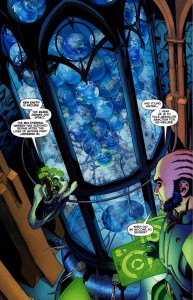
Fig. 4: The Multiversal Orrery and the Monitors. art by J.G. Jones
Final Crisis (New York: DC Comics, 2008) Chapter 1.
Fig. 5: Heimdall and the Gjallarhorn
Sam 66 1765-1766. Wikimedia Commons.
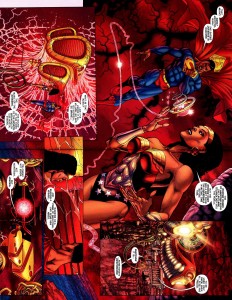
Fig. 6: Nubia and the Wonder Horn. Art by Doug Mahnke,
Final Crisis (New York: DC Comics 2009) Chapter 10.
By David Faust
